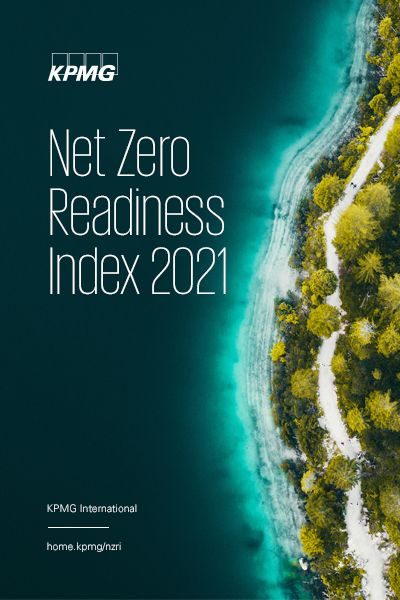Germany’s position in the top five comes down to cross-party ambition and well-established policies on climate change. Its plans to extend use of offshore wind, but exit from nuclear power, requires the country to only gradually phase out coal until 2038.
Political ambition
Germany’s fifth place overall is down to the progress it has already made on decarbonization, contributing to a low emissions intensity compared with GDP, and its ambitious targets for the next few years. In May 2021 the government tightened its legal targets to emissions cuts of 65 percent by 2030 compared with 1990 levels, then 88 percent by 2040 and Net Zero by 2045, after a constitutional court ruling.1
The speed of change could increase in light of September’s national elections after the Green Party won a significant share of the vote and will likely enter a coalition government. Goran Mazar, Head of ESG, KPMG in Germany, says that as environmentalism is accepted by most parties, this would be likely to accelerate existing processes such as by further tightening national emission reduction targets.

“A key political shift in the EU over the past 2 decades has been that climate action, including a green transition, has moved from a mostly left-wing fringe into the political mainstream,” says Henning Gloystein, Director, Energy, Climate and Resources, Eurasia Group. “This is perhaps best seen in Germany, where any of the likely government coalitions following September’s elections will likely mean more climate policy action. With the exception of a few details, all parties that will form the next government believe a green transition will in the longer-term benefit Germany’s industry.”
Renewables mix
Just over half of the country’s electricity comes from low-carbon sources, a quarter of which is made up of wind power. Also, the country’s Energiewende (energy transition) policy is well-established.
However, this transition has been complicated by the country’s 2011 decision to phase out nuclear power by the end of 2022 following the Fukushima disaster in Japan.2 Mazar says that this has led the country to prioritize development of renewable energy, but adds: “It’s difficult to terminate coal and nuclear at the same time.” Germany does not plan to fully phase out coal electricity production until 2038 – a gradual approach but slower exodus when compared to the UK – but market forces such as escalating carbon permit prices in the EU will be likely to bring production to an end much sooner.
There are ambitious plans to develop green hydrogen as part of reducing CO2 emissions, particularly from industry, but Walter Bürger-Kley, Advisory Partner at KPMG in Germany, says that barriers around cost and distribution of infrastructure remain. Similarly, wind generation off the northern coasts will require improved transmission networks to reach the middle and south of the country.

Industrial structure
Germany is ranked fourth on the industry sector. Industry’s strong rating is based partly on government support for circularity, the replacement of fluorinated greenhouse gases and plans for industrial clusters focused on low-carbon industries. Regarding energy-intensive industries, multinational steel maker ArcelorMittal plans to pioneer work on hydrogen-powered blast furnaces at its sites in Germany.3 Mazar says hydrogen is likely to be required to make steel and cement, although it will be hard to make cement, in particular, completely carbon-neutral. This may require greater consideration of ‘embedded carbon’ – that is required for construction rather than operation – in the building sector and the support of renovation over demolition.
The country’s third place in the NZRI for transport is based partly on government support for electric vehicle purchase and ownership incentives, low carbon fuel mandates, and charging infrastructure. Mazar says that the country’s major vehicle makers including BMW, Daimler and VW started development of electric vehicles later than some others, but are now making progress.
On public transport, the Green Party has proposed policies to make flying and driving less attractive – although the disclosure of these policies has contributed to the party slipping in the polls. These include tax changes that would make both modes more expensive and speed limits of 130 kilometers an hour across the autobahn road network, some of which has no speed limit.4
As part of a Buildings Energy Act which came into force in November 2020 Germany is working to decarbonize domestic heating.5 From 2026, the country plans to limit the installation of oil heating systems and fossil fuel heating boilers, a significant step given that buildings contribute 15 percent of emissions.
1 Maria Sheahan, ‘Germany sets tougher CO2 emission reduction targets after top court ruling’, Reuters, 5 May 2021. https://www.reuters.com/business/environment/germany-raise-2030-co2-emissions-reduction-target-65-spiegel-2021-05-05/
2 Christoph Hasselbach, ‘How Fukushima triggered Germany's nuclear phaseout’, DW, 10 March 2021. https://www.dw.com/en/how-fukushima-triggered-germanys-nuclear-phaseout/a-56829217
3 ‘ArcelorMittal Europe to produce ’green steel’ starting in 2020’, ArcelorMittal, 13 October 2020. https://corporate.arcelormittal.com/media/news-articles/arcelormittal-europe-to-produce-green-steel-starting-in-2020
4 Jens Thurau, ‘Germany's Green party: internal strife and drop in opinion polls’, DW, 10 June 2021. https://www.dw.com/en/germanys-green-party-internal-strife-and-drop-in-opinion-polls/a-57848533
5 ‘The new Buildings Energy Act’, German Federal Ministry of the Interior, Building and Community, accessed July 2021. https://www.bmi.bund.de/EN/topics/building-housing/building/energy-efficient-construction-renovation/buildings-energy-act/buildings-energy-act-node.html




